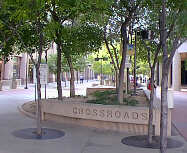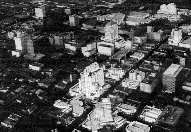 |
Albuquerque, like many other American cities, experienced a post-World War II decline in the vitality of its downtown area caused largely by proliferation of the automobile and the resultant mobility it offered urbanites. Increasingly in the 1950s and 1960s, people bought houses at the city's edges. They shopped, sought recreation, and focused their daily activities at the city's periphery rather than its center.
The establishment of the Winrock and Coronado Shopping Centers in the 1960s
signaled what is probably an irreversible trend in Albuquerque's major retail
patterns. Downtown retail volume dropped off to one-eighth of what it had been
30 years before. Theaters and restaurants closed. The central business district,
once action-packed, crowded and "alive," withered into an area that
closed--figuratively, and almost literally--from the 4:30 p.m. exodus of government
workers and employees of large firms until their return at 8:00 a.m. the next
day.
Toward the end of the 1960s, the federal government attempted to counter the
destructive effects of national urban decay by providing funds for renewal.
Albuquerque received $28 million for the Tijeras Urban Renewal Project, considered
by some the first of three phases in a Downtown revitalization movement. Block
after block of old buildings in the section between Tijeras Avenue and Lomas
Boulevard, from Second to Sixth Street, were razed, making way for the Convention
Center, First Plaza, Civic Plaza, the police station, the Regent Hotel, and
United New Mexico Bank. The Tijeras Project succeeded in anchoring government
offices, major financial elements, and the Convention Center downtown, and in
raising property taxes tenfold over what they had been.
A second phase of revitalization occurred in the mid-1970s when federal revenues were depleted. New sources of funding had to be found if the process of rebuilding Downtown was to continue. Passage of the Metropolitan Redevelopment Act (MRA), and reorganization of Albuquerque Center, Incorporated, (ACI), a quasi-official organization composed of the city, the county, and major downtown financial interests, were primary factors in encouraging the private sector to pick up where government had left off in halting and reversing the downward trend. Under the MRA, qualified investors were able to obtain privately financed bonds that have the legal aura of municipal bonds, thereby carrying low-interest rates and tax exemptions for ten years. These incentives led to the construction of Albuquerque Bell Telephone Company, Federal Credit Union, Sunwest Bank, the high-density residences on Silver between Sixth and Eighth Streets, and to such successful renovations as Copper Square, La Posada, Old First National Bank Building, the Rosenwald Building, the Wool Warehouse Dinner Theater, and the New Mexico Title Company at Gold Avenue and Fourth Street.
The basic concept of "Phase II" was to provide a balanced mix of old and new offices and high- density housing, to increase retail business, and to promote an environment human in scale
The third phase was initiated in 1984, when an energetic movement got under way to make downtown a "magnet" that could attract both city residents and out-of-towners. A variety of conflicting ideas surfaced concerning the best ways to achieve this objective. It was a period in which ideas were discussed by the community regarding the expansion of the Convention Center (now completed), the need for additional hotel space (the Hyatt Regency Hotel has been finished on Civic Plaza), and the Festival Marketplace, which was turned down by the community in a referendum. In the early 1990s, the arts/entertainment sector grew into a major force for revitalizing Downtown as numerous bars, discos, and nightclubs catering to all ages and tastes, including university students, moved into abandoned or under-used retail spaces. Central Avenue in the mid-1990s is often as busy in the late evening as it is at noontime when office workers go to lunch. Most of these entertainment establishments cater to a clientele of moderate to "upscale" means; however, a couple of businesses that involve semi-nude dancers have appeared in spite of efforts to prevent them, a development that causes some concern.
Downtown continues to evolve in the mid-nineties as new retail establishments appear--fast-food restaurants, coffee and pastry houses, and other new buildings, many of which are being built on Lomas Boulevard because of its easy access, available land, and parking. Among these are the First State Bank, Native American jewelry stores, and a new federal courthouse on Fourth and Lomas NW. On Central Avenue, old Route 66, streetscape improvements with colorful lights and landscaping have been added. The Civic Plaza renovation will be completed by 1997, including a series of public art projects like Glenna Goodacre's "Sidewalk Society" sculpture at Third and Tijeras, the contemporary Tom Waldron "Cone 10" sculpture at the main library, two murals on the New Mexico Mortgage Finance Authority building on Second at Gold, the Dr. Martin Luther King, Jr. Memorial across from the Convention Center, and colorful concrete insets along Central designed by Elzbieta Kaleta that depict historic Downtown buildings.
 All
these improvements have resulted from successful collaboration among the public
and private sectors and the Downtown City Center Council, the local merchants'
promotion organization. In addition, city growth and the accompanying demographic
changes are helping to revitalize Downtown. The period between 1950 and 1990
brought a great deal of construction and growth in the Northeast Heights. When
that potential was realized, rapid development began on the west side and west
mesa, a shift that makes the Downtown once again the real center of the city.
The value of Downtown property has increased remarkably; occupation of rental
housing in the city, including Downtown, continues at approximately 97 percent.
All
these improvements have resulted from successful collaboration among the public
and private sectors and the Downtown City Center Council, the local merchants'
promotion organization. In addition, city growth and the accompanying demographic
changes are helping to revitalize Downtown. The period between 1950 and 1990
brought a great deal of construction and growth in the Northeast Heights. When
that potential was realized, rapid development began on the west side and west
mesa, a shift that makes the Downtown once again the real center of the city.
The value of Downtown property has increased remarkably; occupation of rental
housing in the city, including Downtown, continues at approximately 97 percent.
Growth and revitalization are binging new challenges for Downtown Albuquerque. Gentrification will increasingly need to be balanced with maintenance of older, surrounding neighborhoods with their long-time residents.
High-density housing and low-income housing must be added to the Downtown and additional retail opportunities must be developed. New construction should be balanced with renovation of older structures, particularly as Downtown expands to the north around Lomas, to the south along Fourth Street in Barelas--a neighborhood now seeing renovation of its commercial center--and then east to Huning Highlands.
 |
(Up to Section V, Back to Cultural Diversity, On to Energy Resources and Conservation)